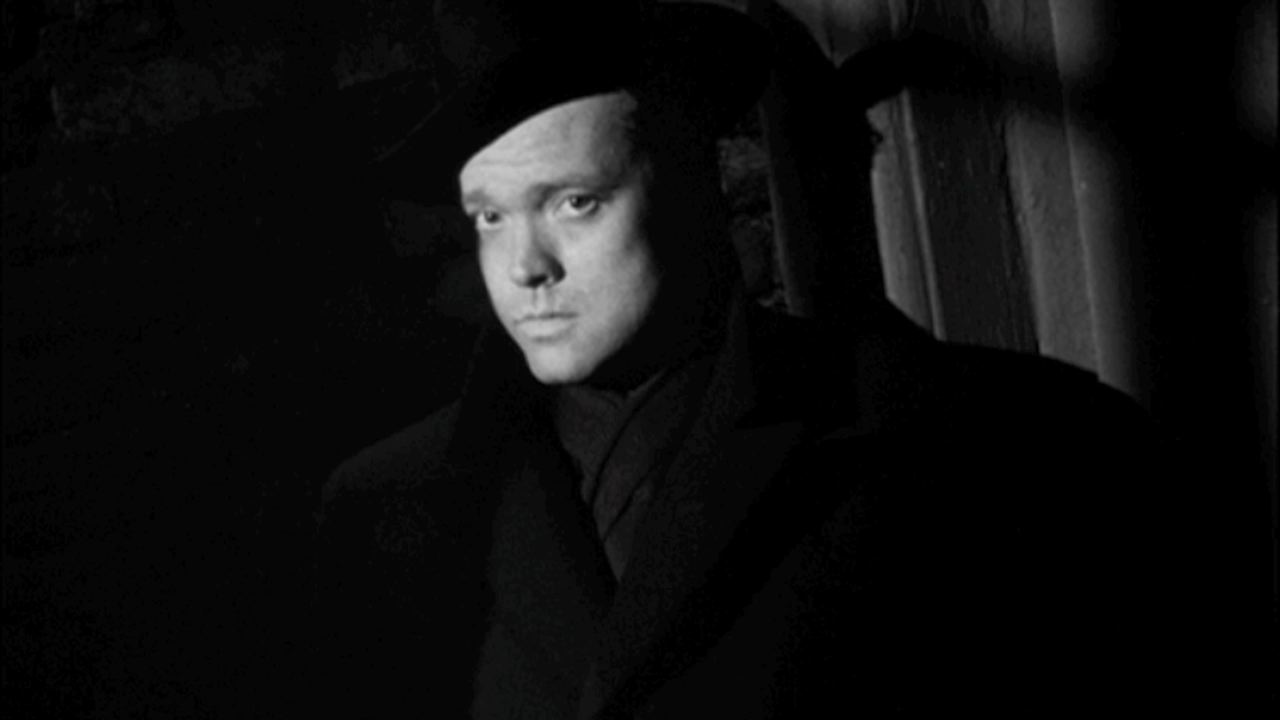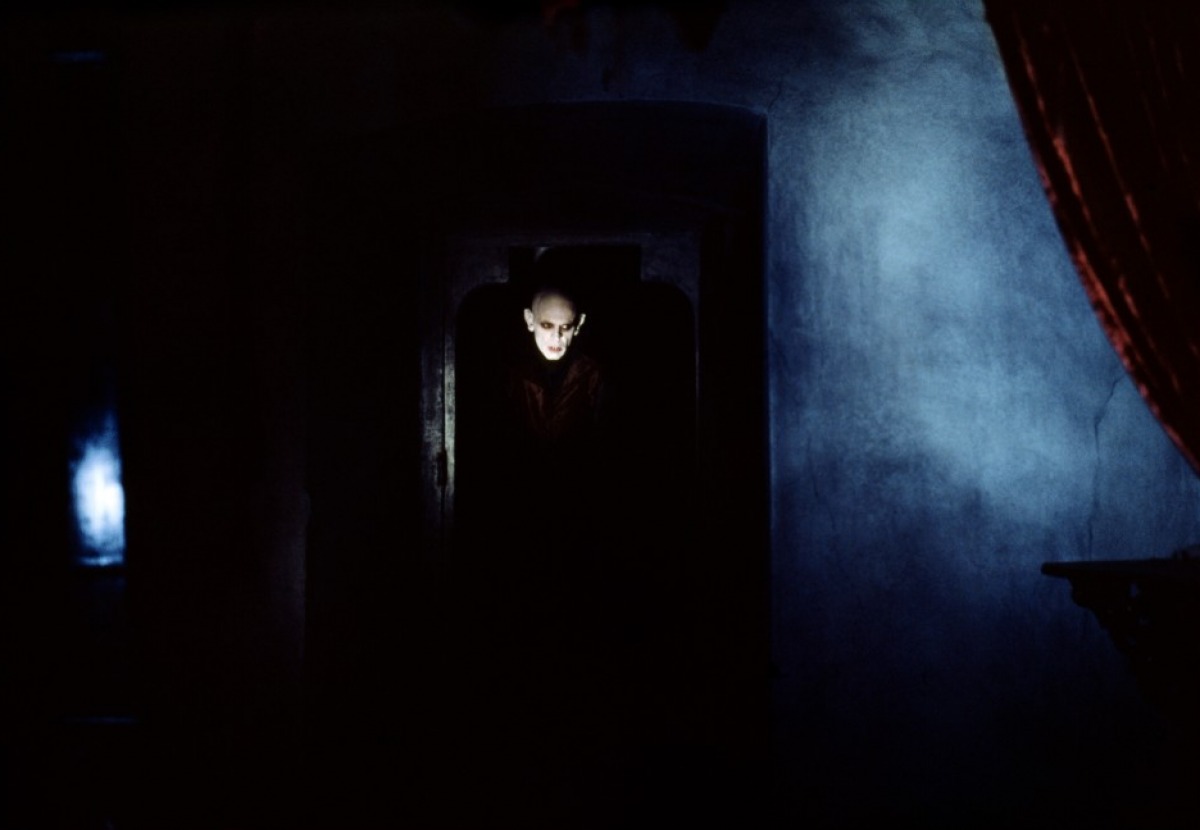
For you few devoted readers who haven’t seen The Third Man (though I can’t imagine that you truly exist at this point) we have carefully avoided spilling the beans up to this point, but after this frame, the cat is out of the bag. This is the face of Harry Lime. True, we have spent much of our analysis talking about Orson Welles, and you may have been wondering this whole time “Hey, isn’t Orson Welles supposed to be in this movie?” but Matt and I have done our best to keep from telling you the truth too soon. But now Holly—as we always hoped he would—has dug up the truth. A ghost stands before him, a stark white face sunk into the shadows of a doorway.
One striking thing I find about this is that, like the porter’s death, the discovery of Harry can also be tied directly to Holly’s big mouth—that and a cat. Holly, on his way out of town and back to the US, has left Anna’s apartment scorned and heartbroken. He has professed his love to her, and like much of his life, has found himself playing second fiddle to Harry. Even in the supposed grave, Harry can outcharm any woman Holly might be interested in, and with the recklessness that come with having nothing left to lose, Holly decides to confront his spook. This spook, who turns out to be Harry, has truly only been revealed by Anna’s cat, who “only liked Harry,” cuddling his way up into the interlopers shoelaces. But Holly, with no fear for his life bursts out to the shadowy figure:
Holly: What kind of spy do you think you are, satchelfoot? What are you tailing me for? Cat got your tongue? Come on out. Come out come out wherever you are. Step out into the light and let’s have a look at you. Who’s your boss?
Tony Danza jokes aside, this string of accusations annoys a neighbor enough that she turns on her light and starts to yell at Holly in German (something like “what’s the commotion? What are they yelling about?”). But both men seem to ignore her, since in turning on her light, her well placed window illuminates the supposedly-dead Harry’s face and the two meet eyes, Holly staring back literally slack-jawed.
Holly, who has already attended Harry’s funeral and spent days (weeks?) trying to honor his friend’s memory, is looking into the eyes of a dead man, a ghost, a phantom. Harry has risen from the dead only to haunt these streets again, and like some kind of phantom, he melts his way out of the darkness behind him. Something in the extreme lighting—diegetically motivated by an angry neighbor turning on her light—makes his face unnaturally white, even luminescent against the shadowy background. And like any number of Draculas, Harry’s face seems to sink into darkness its edges indiscernible from the shadows he has—up to now—occupied. Take for instance, Klaus Kinski’s terrifying visage in Werner Herzog’s 1979 Nosferatu the Vampyre (or its German-language doppelganger Nosferatu Phantom der Nacht):

How could Holly’s response to such a ghastly face from beyond the grave be met with anything but terror? Holly’s response can only be explained by this terror. His goal since he first set foot in this shadowy city of ghosts has been to find out the secret behind Harry’s mysterious death, and who better to elucidate these secrets than the murdered man himself? Yet Holly stands rooted to the spot as this face from his childhood stares out, vampirically sunk into its own doorway.What thoughts could be heading through Holly’s head? Truly he could be imagining that he is seeing some creature of the night, a vampire or ghoul that has come to stalk him, or from a more Shakespearean bent, he could imagine that Harry’s ghost might be visiting him to send him a message. Let’s not get into the hypothesis that Holly sees himself as the Hamlet of our story, but only imagine the myriad understandings that are whirling through his head.
Perhaps our most believable hypothesis for Holly’s thoughts lies in one of the most traditional cinematic tropes, the flashback. And indeed, both of our lead actors may be linked to our contemporary understanding of the flashback, since Citizen Kane so shaped our understanding of the technique. But for Holly, standing in a Vienna street and looking at Harry, he may be thinking not of his present-day legally dead racketeer of a friend, but instead of the friend he knew and loved. Holly may see Harry here, admittedly after a few swigs of whiskey, and find himself disoriented and wondering where he is, if he might just be back at the boys school where their friendship was forged. He may find himself, like Billy Pilgrim, temporarily unstuck in time, and wonder, not about Harry, but about himself as he stares at this face that has literally swum up out of his past. We recently consulted with Nietzsche on the presence of animals in this film, and again we must seek his guidance for Holly. In The Gay Science he writes:
What if some day or night a demon were to steal into your loneliest loneliness and say to you: ‘This life as you now live it and have lived it you will have to live once again and innumerable times again; and there will be nothing new in it, but every pain and every joy and every thought and every sigh and everything unspeakably small or great in your life must return to you, all in the same succession and sequence—even this spider and this moonlight between the trees and even this moment and myself. The eternal hourglass of existence is turned over again, and again and you with it, speck of dust!’ Would you not throw yourself down and gnash your teeth and curse the demon who spoke thus? Or have you once experienced a tremendous moment when you would have answered him: ‘You are a god, and never have I heard anything more divine’ (Friedrich Nietzsche, The Gay Science, University Press, Cambridge, 1882, translated in 2001, section 341, pg. 194)
This is Nietzsche’s first introduction of the concept of eternal recurrence, something that would become essential to his later, more unhinged, philosophical works, but as we look into today’s Still Dots and temporarily become Holly Martens we must wonder, how does he feel? Is it the essential terror of self doubt that glues his boots to the floor, worrying that he must again live in Harry’s shadow, write novels, and come to find him dead again or is it some personal holy feeling? Is this moment the tremendous moment that Nietzsche describes, finding a friend he thought was dead alive and staring out from a Vienna doorway? Holly seems like he could go either way, and both could explain his suddenly sticky soles.
Ironically, it is something positively boyish that breaks the spell. It is only after Harry’s face twists into a charming boys-will-be-boys smirk that Holly can shake the terror from his frozen joints and chase him. Unfortunately for us, our regimented analysis didn’t catch this exact frame, one I personally consider to be one of the greatest closeups in the history of the artform, but I will show it to you anyway, off the record. In fact, I am so enamored with this elusive smirk that I tried to reproduce it myself, with middling results. Orson Welles is doubtless one of the great artists of our time, and this smirk may well be counted among his masterpieces.
But about the face we see here, sources differ. Orson Welles got his start in radio, but in his case the old adage may be wrong, he didn’t have a face for radio. But is this stunning face really Welles? Though lit with a ghostly glow, and certainly much more of a pure white, he looks a lot like the young man he played in Citizen Kane eight years earlier. But of his face in Kane, Welles said in an interview with Peter Bogdanovich:
Orson Welles: But the thing that’s never been printed is the truth about me as a young man in that film. I was then twenty-five, twenty-six—I’ve forgotten how old I was—but I had my face lifted up and wore corsets for the scenes as a young man.
Peter Bogdanovich: Why? Were you heavier than you looked?
Orson Welles: Of course. Not only heavier, but I always had that terrible round moon face and it was all faked up with fish skins and tucked under the hair. Everything. Just as though I were some terrible old leading man at the end of his day [laughs] So I was just as heavily made up as a young man as I was as an old man! I could hardly move for the corsets and the fish skin and everything else. I read once—Norman Mailer wrote something or other—that, when I was young, I was the most beautiful man anybody had ever seen. Yes! Made up for Citizen Kane! And only for five days!

So today’s still again presents a bizarre image, one seemingly out of the past. Joe Cotten has certainly aged in the eight years since Kane, but Welles’s own face seems nearly identical to Kane’s. What’s more, that face never existed in the first place, since it was all held together with corsets and fish skins. Yet somehow, we are looking on that same face again. Though it may not be quite as striking for us viewers, who don’t have the personal connection that Holly and Harry have (or even Joe and Orson, for that matter) but the face that stares out at us from the shadows seems oddly out of place. We, in 1949, might have found our stomachs twisting inside as this face first flashes on the screen, and depending on how steadfast our grip on reality, we might wonder if it really isn’t closer to 1941. If turning the wrong corner on one of these winding Vienna alleys, we might have ended up in a different time, the same feeling that doubtless runs through Holly’s mind.
This face is a good example of what Jean Baudrillard would call a simulacrum, a copy of a copy of a copy with no original. Baudrillard would write of the simulacrum: “The simulacrum is never that which conceals the truth–it is the truth which conceals that there is none. The simulacrum is true.” And so Harry’s/Welles’s face is a truth which reveals that there is none, that face has never existed any more than any noble image of Harry has ever existed. It’s all just been a case of smoke and mirrors.
Over the absolute length of one year — two times per week — Still Dots will grab a frame every 62 seconds of Carol Reed’s The Third Man. This project will run until December 2012, when we finish at second 6324. For a complete archive of the project, click here. For an introduction to the project, click here.
Get Walker Reader in your inbox. Sign up to receive first word about our original videos, commissioned essays, curatorial perspectives, and artist interviews.